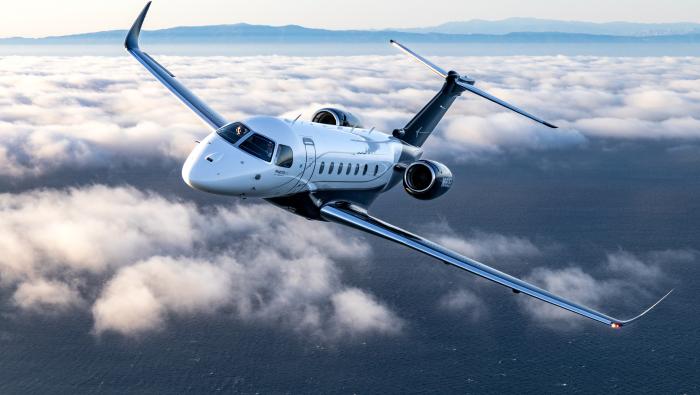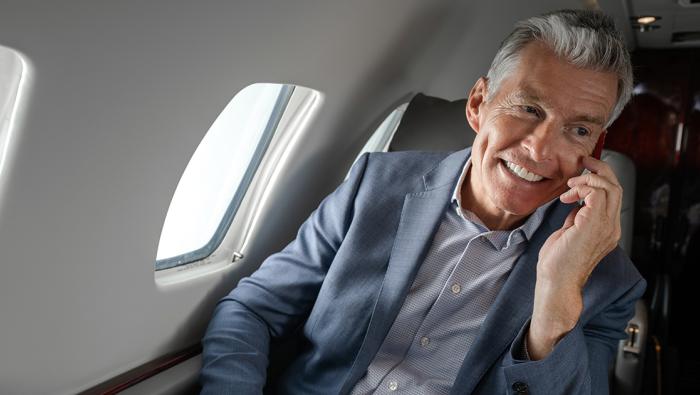
Business jet deliveries rose by nearly 10% in the first half of the year versus the same period in 2024, according to the latest GAMA quarterly general aviation aircraft delivery report. OEMs handed over 354 business jets through the first six months compared to 322 a year ago, contributing to a more than $1 billion increase in aircraft billings, to $12.3 billion for the period.
All of the major business jet OEMs either saw improvement or equaled their performance from last year. Embraer saw the largest percentage increase (36%), delivering 61 business jets in the first half. Gulfstream also reported a significant improvement year-over-year, with the Savannah airframer handing over 13 more aircraft in the first six months of 2025.
The turboprop segment overall saw a 4.3% decrease in deliveries year-over-year, and while rotorcraft deliveries for the first half of the year saw minor erosion, billings for the segment rose by 20% to $2 billion.
“It is encouraging to see continued growth within some of the general aviation aircraft segments through the first half of the year,” GAMA president and CEO James Viola told AIN. “To sustain and improve this trajectory for the industry, it will be important that we continue working to address ongoing supply-chain issues and trade negotiations that will maintain the industry’s position as a leader in driving innovation, enhancing safety, and strengthening economic opportunities.”
|
A U.S.-registered Bombardier Global 7500 en route from Teterboro Airport (KTEB) to Costa Smeralda Airport (LIEO) in Sardinia, Italy, diverted to Gander International Airport (CYQX) after receiving reverser caution messages and an uncommanded power reduction. The August 24 incident was reported by the Transportation Safety Board of Canada (TSB).
The jet was flying IFR at FL410 when the flight crew received two caution messages: L REVERSER FAIL and L REVERSER LOCK FAIL, accompanied by a power reduction to flight idle of its left side engine. According to the TSB report, the crew completed the appropriate checklist, which required reducing airspeed to 170 kias and landing at the nearest suitable airport.
After reducing airspeed, the crew declared an emergency and coordinated with Canadian air traffic services (ATS) to descend to 10,000 feet. “An extended pattern was flown to achieve a landing weight below maximum limits and the crew coordinated with ATS for a diversion to [CYQX], where a landing was made without further incident,” the report states.
The TSB report said the aircraft operator coordinated troubleshooting with General Electric, the manufacturer of the Global 7500 Passport turbofans. A faulty engine electronic controller, a critical element of the Fadec, was identified. “We’ve communicated with the operator,” a GE spokesperson told AIN. “A software fix is introduced in [new production aircraft] and is being deployed in the field via a service bulletin.”
|
During a panel discussion at the 2025 JetNet Summit in Washington, D.C., this week, industry executives highlighted unprecedented global wealth creation as the primary catalyst driving business aviation demand while acknowledging that supply-chain bottlenecks continue to constrain growth.
Thierry Betbeze, CEO of Dassault Falcon Jet, and Michael Amalfitano, president and CEO of Embraer Executive Jets, outlined how wealth generation rather than traditional market factors is reshaping the industry landscape. In a conversation with moderator Pete Bunce, the executives addressed regional market variations, technological innovations, and persistent supply-chain challenges.
Credit Suisse projects more than 20% wealth growth through 2029. Both executives noted that despite geopolitical tensions and regulatory challenges, underlying demand remains robust. “People who want business jets buy business jets. Who cares what the noise is in the marketplace?” Amalfitano stated.
Embraer and Dassault both leverage their diversified portfolios to accelerate innovation across business aviation platforms. Dassault continues to develop single-pilot operations despite EASA’s recent pause in research, drawing from military and defense technology advances. The Falcon 10X will incorporate new cockpit designs focused on reducing pilot workload through enhanced automation and navigation systems, including a single-control throttle for both engines and an upset recovery mode. “Knowing that the two pilots will have a lower workload means more safety [and] more comfort for passengers,” Betbeze stated.
|
Regional charter platform Flyvbird has launched operations with its first flights carrying passengers in Germany this month between Friedrichshafen and Mönchengladbach airports. The per-seat trip booking service, which provides flights with aircraft operated by partners, is also now offering connections to Strausberg, near Berlin, as well as Hof, Straubing, and Mannheim.
Flyvbird is also now rolling out its new commercial brand name, Vini. This is based on the electric blue feathers of the lorikeet bird, which the company said "stands out, adapts, and is always in motion.”
Following a ‘test flight’ between Vilshofen and Friedrichshafen on August 31, fully-booked commercial services onboard the nine-passenger Cessna Caravan started on September 1. “Vini is now in its pilot phase and weekly departures are live,” confirmed the company, which claims to have received more than 30,000 requests via its booking platform for potential routes prior to the launch. Four sectors were flown in the first day of operations.
Vini is primarily targeting business travelers through the launch of what it describes as Europe’s “scalable on-demand network for regional air mobility.” Passengers were able to book through Vini’s proprietary AI-driven app, which the company says is key to “efficiently pool decentralize traffic streams and optimise on-demand commercial offers” at “competitive prices with trains and cars.”
|
Sponsor Content: Gogo
Gogo customer support is ever-present, wherever our customers are flying around the globe.
|
The Canadian Business Aviation Association (CBAA) announced that Anthony Norejko will be transitioning out of his role as CEO as part of a planned leadership succession process.
Norejko has served as CEO for seven years, leading the association through a period of significant challenges and growth, including navigating the Covid pandemic’s impact on the aviation sector, federal election cycles, the implementation of luxury tax legislation, and ongoing advocacy efforts regarding airport access and infrastructure issues.
“Anthony has provided exceptional leadership during some of the most challenging times our industry has faced,” said Andy Nureddin, chair of the CBAA board of directors. “His strategic vision and unwavering commitment to our members has significantly advanced our industry influence during a critical period for business aviation in Canada.”
The CBAA board has initiated a comprehensive search process for Norejko’s successor. To ensure continuity of operations and strategic initiatives, Norejko will remain with the association in a transitional capacity until the right leader is identified and successfully onboarded.
“It has been an extraordinary privilege to serve this association and our members,” said Norejko. “The accomplishments we’ve achieved together—from strengthening our industry to advancing critical industry initiatives—belong to our entire community: the board, staff, members, and stakeholders who believed in our shared mission.”
|
Luxaviation Group has signed a new 15-year sustainable aviation fuel (SAF) partnership with Haffner Energy. The non-exclusive offtake agreement in Europe will include fixed SAF volumes and price terms, the latter described by Luxaviation as being “within the lower end of current industry benchmarks.”
Due to be finalized in September 2026, the upcoming agreement formalizes discussions that have been ongoing since June. It builds upon Luxaviation’s “Go-to-Zero” investment fund, launched in 2023 to foster SAF production. Both parties are also members of Project SkyPower, an international initiative dedicated to accelerating the development and adoption of SAF.
Luxaviation describes the use of SAF as one element of a three-pronged decarbonization strategy that also includes improvements in fuel efficiency and the use of carbon offsets. Group CEO Patrick Hansen believes the partnership is “setting the benchmark for how business aviation can accelerate the scale-up of sustainable fuel production across Europe.”
Haffner Energy co-founder and CEO Philippe Haffner explained that the offtake partnership will “significantly facilitate the financing of [its] SAF projects in Europe,” including development of upcoming facilities in France and Iceland. “Securing long-term offtake agreements is one of the most crucial conditions for financing SAF production facilities, as they guarantee the purchase of SAF at a stable price over periods exceeding five years,” he concluded.
|
Otto Aerospace has trained a proprietary AI model to help speed up the process of configuring laminar-flow airfoils and design features so that the Phantom 3500 light jet can offer midsize-jet performance. The AI model uses Luminary Cloud’s GPU-accelerated Physics AI platform and its Shift-Wing physics model for aerodynamic analysis of transonic wings, according to Otto.
Two Williams International FJ44 turbofans mounted conventionally on the rear fuselage will power the Phantom 3500. The first flight is expected in 2027, and FAA certification in 2030. With a mtow of 19,000 pounds, the Phantom 3500 will be able to cruise at FL510, and offer NBAA IFR range with four passengers and a 100-nm alternate of 3,200 nm. The jet's fuselage has no windows in the cabin, which helps with aerodynamic smoothness. Passengers will have views of the outside world and other vistas on large screens in the cabin.
“Our Phantom 3500 program has generated extensive high-fidelity simulation and wind-tunnel test data,” said Obi Ndu, chief information and digital officer at Otto Aerospace. “At Otto, we believe that the future of aircraft design is at the intersection of artificial intelligence and first principles. Luminary’s platform gives us the computational power and infrastructure to quickly train an AI model optimized for next-generation laminar flow aircraft and our unique design approach.”
|
Virtual display startup Brelyon is helping solve simulator motion sickness issues with display innovations. There is a significant effort underway to replace flight simulator visual systems with virtual- or mixed-reality (VR or MR) headsets, which give the user an unlimited field of view in any direction. Headsets also have the advantage of eliminating simulators’ bulky visual displays, which have a narrower field of view and add significant cost to the price of training devices.
At the same time, not everyone adapts to VR or MR without experiencing mild or even worse motion sickness. Brelyon has developed an alternative, a so-called “immersive monitor” that looks and feels like the view through a headset without having to wear a head-mounted device, and provides true depth and simultaneous views of multiple layers.
The U.S. Air Force has adopted headset-based training in its Pilot Training Next program but found that 24% to 27% of students were unable to tolerate more than seven minutes in the VR/MR world, according to Alok Mehta, COO and co-founder of Brelyon.
That solution is Brelyon’s Ultra Reality and Ultra Reality Extend immersive monitors, which allow for information to be layered, with “multiple data streams at varying depths,” according to the company, enabling users to “visualize vast amounts of data in an organized and easily accessible way.” That includes arranging the data layers as needed and also adjusting the transparency of each layer.
|
SUSTAINABILITY QUESTION OF THE WEEK
Does electric flight add noise pollution?
- A. Yes, because electric motors are louder than traditional engines.
- B. Only during takeoff and climb.
- C. It depends on the battery size.
- D. No, electric aircraft are generally quieter than conventional aircraft.
|
AIN’s Corporate Aviation Leadership Summit (CALS) Mx, set for November 3 to 4 in Scottsdale, Arizona, will address the latest topics, strategies, and solutions in business aviation. The summit is attendee-centric, serving as an educational and professional networking opportunity that connects directors of maintenance and corporate aviation leaders with peers, industry experts, and solution providers in a relaxed environment. The event is limited to 50 attendees, so we encourage you to apply to attend this all-expenses-paid event as our guests.
|
Robinson's R88 Model Supersizes Its Helicopter Family
The new R88 rotorcraft is significantly larger than the R22, R44, and R66 models the California company has produced so far, with room for up to 10 seats and the ability to carry up to 1,800 pounds of payload.
|
UPCOMING EVENTS
- CORPORATE AVIATION LEADERSHIP SUMMIT EUROPE
- BASEL, SWITZERLAND
-
 September 15 - 17, 2025 September 15 - 17, 2025
- NATIONAL AVIATION HALL OF FAME ENSHRINEMENT 2025
- WICHITA, KANSAS
-
 September 19, 2025 September 19, 2025
- MONACO YACHT SHOW
- MONACO
-
 September 24 - 27, 2025 September 24 - 27, 2025
- NORTH AMERICAN SAF CONFERENCE & EXPO
- MINNEAPOLIS, MINNESOTA
-
 September 24 - 25, 2025 September 24 - 25, 2025
- RACCA ANNUAL CONFERENCE
- SCOTTSDALE, ARIZONA
-
 September 30 - October 2, 2025 September 30 - October 2, 2025
|
 |
|
AINalerts News Tips/Feedback:
News tips may be sent anonymously, but feedback must
include name and contact info (we will withhold name on request). We reserve the
right to edit correspondence for length, clarity, and grammar. Send feedback or
news tips to AINalerts editor Chad Trautvetter.
|
AINalerts is a publication of AIN Media Group, 214 Franklin Avenue, Midland Park, New Jersey. Copyright 2025. All rights reserved.
Reproduction in whole or in part without permission is strictly prohibited.
|
|


















